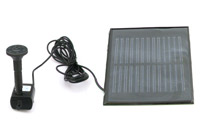When to Choose a Solar Powered Water Pump
The prospect of using a solar powered water pump to harness free energy is a fairly exciting idea to a lot of people. The sun is constantly producing energy; around 1000 Watts per square meter of the earth's surface (10 square feet). Best of all, it's completely free for the taking if you want it! By choosing a solar device, you can also feel good about using a renewable energy source, which is good for the environment. Along with these benefits come a few limitations of course. Whether or not the limitations of solar energy will have a negative effect on your particular project will depend on your particular use. Keep reading below for more info on the limitations of solar.
How Solar Pumps Work
The actual pump in a solar powered water pump is the same as a regular 'plug-in-the-wall' electricity driven pump. The only real difference lies in the source of the electricity. Instead of plugging a solar powered pump into an electrical outlet, it's plugged into a solar panel instead. A solar panel works by absorbing light from the sun, and through a chemical reaction, produces free flowing electrons, also known as electricity.
How Much Sun is Required?
One common source of confusion with regards to solar powered water pumps is the question of how much sun is required to successfully power the pump? Does it have to be perfectly sunny? What if a cloud blocks the sun? The answer is... it depends. The sun's energy varies throughout the day and at some point in the day (usually around 12pm), the sun will reach it's peak intensity. If it's a clear day (ie. no clouds), this is the point at which a solar powered water pump will reach it's peak output. As the day progresses and the sun gets lower in the sky, the power output of a solar panel will naturally decrease until dark at which point power output will halt altogether. In the same way, anything that obstructs the sun during the day, such as clouds, trees and buildings, will also have an effect on the output of the panel. For example, if the sun is obstructed by some light cloud cover, it is still possible depending on the time of day, to achieve greater than 50% of the solar devices direct-solar output. In terms of a pump, that means you could still achieve a reasonable flow rate as long the clouds don't get too thick, or the sun isn't too low in the sky.

Practicality
Whether or not a solar powered device is the right choice in a certain situation depends on the importance of it's job. For example, if powering a pump that is used to supply an aesthetic fountain in a pond, then solar energy might be a good choice since the continued operation of a fountain is not mission critical to the health of the pond. On the other hand if a solar powered water pump was used to feed the main filtration of a koi pond, you will most likely end up with a problem since the continued operation of a koi pond filtration system is very important. Unless some kind of battery system is used to store extra energy converted during the day to carry the pump through the night, the pump will not be running often enough to support a healthy ecosystem.
Conclusion
A Solar powered water pump is an excellent piece of equipment as long as the purchaser knows the limitations of the device up front. If continued operation is not essential, then nothing beats using free energy from the sun. Although the cost of buying a solar device might be higher up front, the electricity savings will add up over time, possibly paying for the device many times over. To learn more about pumps in general, please visit our page on pond pumps.
Click Here to Return from Solar Powered Water Pump to Pond Pumps
